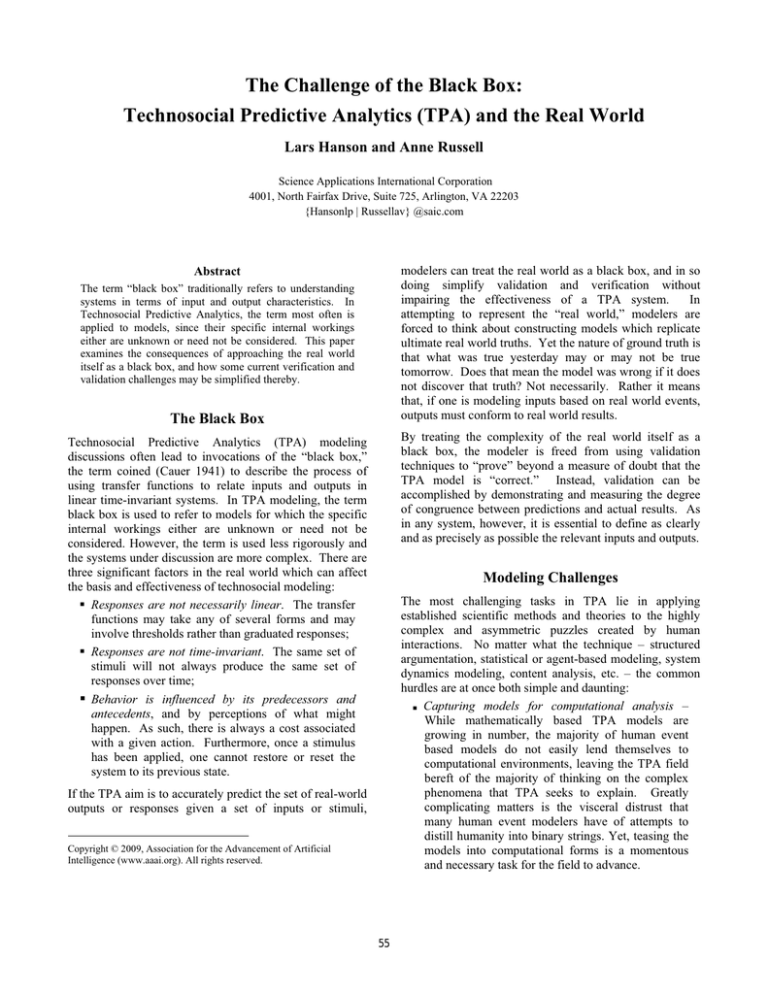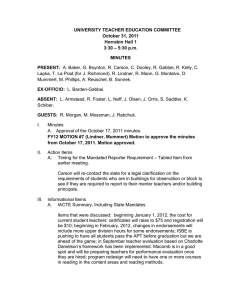
The Challenge of the Black Box:
Technosocial Predictive Analytics (TPA) and the Real World
Lars Hanson and Anne Russell
Science Applications International Corporation
4001, North Fairfax Drive, Suite 725, Arlington, VA 22203
{Hansonlp | Russellav} @saic.com
modelers can treat the real world as a black box, and in so
doing simplify validation and verification without
impairing the effectiveness of a TPA system.
In
attempting to represent the “real world,” modelers are
forced to think about constructing models which replicate
ultimate real world truths. Yet the nature of ground truth is
that what was true yesterday may or may not be true
tomorrow. Does that mean the model was wrong if it does
not discover that truth? Not necessarily. Rather it means
that, if one is modeling inputs based on real world events,
outputs must conform to real world results.
Abstract
The term “black box” traditionally refers to understanding
systems in terms of input and output characteristics. In
Technosocial Predictive Analytics, the term most often is
applied to models, since their specific internal workings
either are unknown or need not be considered. This paper
examines the consequences of approaching the real world
itself as a black box, and how some current verification and
validation challenges may be simplified thereby.
The Black Box
By treating the complexity of the real world itself as a
black box, the modeler is freed from using validation
techniques to “prove” beyond a measure of doubt that the
TPA model is “correct.” Instead, validation can be
accomplished by demonstrating and measuring the degree
of congruence between predictions and actual results. As
in any system, however, it is essential to define as clearly
and as precisely as possible the relevant inputs and outputs.
Technosocial Predictive Analytics (TPA) modeling
discussions often lead to invocations of the “black box,”
the term coined (Cauer 1941) to describe the process of
using transfer functions to relate inputs and outputs in
linear time-invariant systems. In TPA modeling, the term
black box is used to refer to models for which the specific
internal workings either are unknown or need not be
considered. However, the term is used less rigorously and
the systems under discussion are more complex. There are
three significant factors in the real world which can affect
the basis and effectiveness of technosocial modeling:
Responses are not necessarily linear. The transfer
functions may take any of several forms and may
involve thresholds rather than graduated responses;
Responses are not time-invariant. The same set of
stimuli will not always produce the same set of
responses over time;
Behavior is influenced by its predecessors and
antecedents, and by perceptions of what might
happen. As such, there is always a cost associated
with a given action. Furthermore, once a stimulus
has been applied, one cannot restore or reset the
system to its previous state.
Modeling Challenges
The most challenging tasks in TPA lie in applying
established scientific methods and theories to the highly
complex and asymmetric puzzles created by human
interactions. No matter what the technique – structured
argumentation, statistical or agent-based modeling, system
dynamics modeling, content analysis, etc. – the common
hurdles are at once both simple and daunting:
Capturing models for computational analysis –
While mathematically based TPA models are
growing in number, the majority of human event
based models do not easily lend themselves to
computational environments, leaving the TPA field
bereft of the majority of thinking on the complex
phenomena that TPA seeks to explain. Greatly
complicating matters is the visceral distrust that
many human event modelers have of attempts to
distill humanity into binary strings. Yet, teasing the
models into computational forms is a momentous
and necessary task for the field to advance.
If the TPA aim is to accurately predict the set of real-world
outputs or responses given a set of inputs or stimuli,
Copyright © 2009, Association for the Advancement of Artificial
Intelligence (www.aaai.org). All rights reserved.
55
Definitions – Defining a particular human event
based problem clearly enough for computational
modeling is difficult. Most human event based
issues have multiple and frequently competing
definitions, almost all of which are inexact. How
does one distinguish “rebellion”, for example, from
other forms of armed conflict – a coup, an
insurgency, or a civil war – all of which share
common dependent variables?
Paucity of data – Distinct social or behavioral
phenomena are a relative rarity. How does one
build and test models for “coup” when there are less
than 3500 instances of armed conflict worldwide
from 1946 to 2006? How will one build a coup data
set when coups are grouped together with wars,
invasions, revolutions, insurgencies, and armed
separatist or nationalist movements among other
armed conflict events (Schrodt 2001)? 3500 may
seem like a large number of instances, yet these
occurrences are of differing types and are
distributed over various geographic and cultural
regions and under so many varying conditions that
in fact the numbers of truly similar events are in the
single digits.
Propositions –The majority of political, social, and
behavioral theoretical models rely on subjective
interpretations of speculative propositions presumed
to represent “truth.” How can one verify that a
particular theoretical proposition has any connection
to events in the real world? Are there sound,
repeatable experimental bases for such models?
Are the premises falsifiable? How does one know
whether the theoretical model will act as expected?
How will a model predict the unknowable until it is
observable?
Campbell 2001) techniques offer great potential for
interpreting existing real world data.
Under the right conditions and circumstances, QED allows
human events modelers to re-use existing observational
data which has been gathered for other purposes to conduct
additional analyses which constitute experiments differing
from the original. In conducting and analyzing such
experiments, the modeler can address only the data subsets
of interest, thereby significantly reducing both modeling
and computational complexity.
Furthermore, causal
inferences and relationships can be detected and measured
without first requiring a human event-based model to
“explain” the relationships.
Thus, under the right conditions, the use of quasiexperiments makes it possible to approach the real world
as a black box. One has examined and quantified the
causal inferences to be drawn between inputs and outputs
without regard to the actual internal mechanism causing
the observed relationships. Furthermore, the analysis of
the experimental data provides strong arguments in support
of the relationships being modeled.
Finally, the use of experimental techniques such as QED
allow modelers to divorce the evaluation and validation of
techno-social predictive analytical performance from any
need to evaluate and validate the underlying sociological,
political, psychological, economic, or other human eventbased theories explaining the behavior observed. While
some analysts and human event modelers may find such an
approach less than satisfying, having solid experimental
results supporting the model’s relationships and its
repeatability over time, will only bolster the credibility and
usefulness of the model in real world applications.
It may well be that not every phenomenon being modeled
will require a black box approach to the real world. It may
also be that not all phenomena of interest can be expressed
adequately based on a black box approach. It is almost
certain that more complex models will require a
combination of techniques to capture the phenomena of
interest adequately. However, it is clear that in all cases,
whatever models are used must at least pass the real world
black box test – that alone is sufficient, and to fail to do so
is to fail validation.
TPA modelers will confront these four key challenges
consistently with any attempt to predict events in the real
world. However, by approaching the real world as a black
box, the modeler need only find a transfer function which
will produce the observed set of outputs for a given set of
inputs, and need not resort to any speculation about
internal causes of the behavior. Rather the modeler must
focus efforts on assuring that outputs reflect inputs well
enough and with sufficient accuracy that multiple end users
will have confidence the results are reliable, reproducible,
and actionable. Such an approach allows the use of results
based on reproducible experiments.
Metrics Challenges
Often metric regimes are geared more toward satisfying
transfer function metrics for computational analysts,
specifically those who build and use modeling tools to
explain human event based phenomena. Such regimes all
too often are explained in mathematical terms and focus on
the performance of the engine driving the model.
Quasi-Experimental Design (QED)
Given the practical and ethical difficulties inherent in
human event analysis, developments in the application of
quasi-experimental design (QED) (Shadish, Cook, and
Yet by its very nature, metrics in technosocial predictive
analytics must satisfy the two distinct audiences with
56
different needs: the analysts who must test the model’s
theoretical underpinnings, and the operational user who
must have reason to trust that their model mimics the real
world with sufficient fidelity for their needs.
Additional metrics must be developed for comparing
model performance against ground truth.
By approaching the real world as a black box, the TPA
system evaluator is relieved of the burden of having to
demonstrate that an asserted internal functioning is in fact
correct. The social or behavioral reasoning behind any
specific transfer function employed is irrelevant, as long as
the transfer function faithfully relates inputs and outputs in
the real world. This greatly simplifies comparison
between a TPA model’s results and real-world events
(“ground truth”), as it is not necessary to confirm the
accuracy of any particular theory, only to validate that the
transfer functions relating inputs to outputs are accurate.
Analysts and/or social scientists need metrics that allow
them to measure the social science-based construct of their
theoretical world, i.e., the indicators and/or combination of
indicators that lead to certain complex events. For
example, if the TPA modeler asserts that a history of abuse
is always, frequently, or rarely a necessary condition for an
escalation in violence to occur, how will the modeler prove
the hypothesis? Under what conditions will the hypothesis
hold true? If the hypothesis holds true, how does one treat
an anomaly? When do anomalies become evidence of new
truths?
Systems engineers tend to consider a model as a series of
algorithms which process data to produce an output.
Social scientists, on the other hand, want models to test
some particular social or behavioral theory, to explain
phenomena, and to implement and test assumptions about
the real world. However, in TPA a specific model need
not embody any particular theoretical social science
construct, but need only implement transfer functions
which accurately relate real-world inputs and outputs.
When assessing TPA systems, how does one devise
evaluation metrics which can meet scientific standards,
satisfy analytical expectations, and provide credibility for
the TPA model’s average user? There are two basic
metrics questions:
1. Did the modeler build the model correctly – i.e.,
did the modeler verify (DoD 1994; DoD 1995) that
the model accurately implements the modeler’s
concept?
2. Did the modeler build the correct model – i.e. did
the modeler validate (DoD 1994; DoD 1995) the
degree to which the model is an accurate
representation of the real-world from the
perspective of the model’s intended uses.
Operational end users tend to think of models as a means
to “explain” human-based phenomena in terms of cause
and effect, and to forecast events and the potential
consequences of actions. Why a particular model is
effective in explaining an event and the world context
within which the model makes a prediction are less
important than the fact that it does so successfully.
Because operational users want to know what factors drive
the phenomena – e.g., what factors would cause a coup to
happen or not happen at the predicted time – validation is
essential. It is the process which confirms the model’s
relationships between inputs and outputs. Without such
testing, the operational end user has no basis for trusting
the model.
Of these two, verification generally is easiest to answer,
since the model behavior was specified before having been
written into a computer program. Validation, however, is
far more difficult, highlighting why problems of model
construct, definitions, paucity of data, and propositions
quickly become relevant to TPA. The core question
reduces to one of assessing the degree to which the
model’s behavior faithfully emulates and forecasts realworld behavior. As such, when validating real world
events, questions of relevancy, specific core behavioral
definitions, and so on are significant.
Conclusions
The success of any TPA modeling system ultimately rests
on the confidence all parties have in the validity,
reliability, and utility of the system’s output predictions.
Demonstrating a model’s credibility requires a defensible,
verifiable, and repeatable approach to measuring the
effectiveness and accuracy of the system. While a
necessary component of any evaluation effort, traditional
metrics cannot accurately assess a TPA system.
Traditional accuracy, precision, and recall (APR) metrics
are based on the assumption a model’s predictions are
either true or false. That may or may not be the case in
predicting human, individual, and group behaviors. If a
model assigns probabilities to different possible outcomes,
then clearly traditional APR metrics are inappropriate.
Furthermore, once an outcome occurs, all real-world
probabilities collapse to certainties. It is very difficult to
obtain reliable estimates of how likely different possible
outcomes actually were. “Ground truth,” in this case, is
elusive at best, and most likely not accessible. For this
reason, traditional classifier metrics are insufficient of
themselves, most particularly in measuring TPA accuracy.
Treating not only the TPA models but also the real world
as black boxes reduces validation to comparing the
responses of the two systems to given inputs. This also
permits validating a model against experimental behavioral
science results. Such comparisons are not easily done
experimentally – while one can run the model several
57
times and measure its behavior, it is not possible to run the
real world several times for comparison. In that case, the
question of user confidence ultimately rests on the
system’s performance over time.
References
Cauer, W. 1941. Theorie der linearen Wechsel-stromschaltungen, Vol.I. Akad. Verlags-Gesellschaft Becker und
Erler, Leipzig.
DoD Directive 5000.59. 1994. "DoD Modeling and
Simulation (M&S) Management."
DoD 5000.59-P. 1995. "Modeling and Simulation Master
Plan."
Schrodt, P. A. 2001. “Automated Coding of International
Events using Sparse Parsing Techniques,” Paper presented
at the International Studies Association, Chicago, 21-24.
Shadish, Cook, and Campbell. 2001.Experimental and
Quasi-Experimental Designs for Generalized Causal
New York:
Houghton Mifflin
Inference, 2nd Ed.
Company.
58








